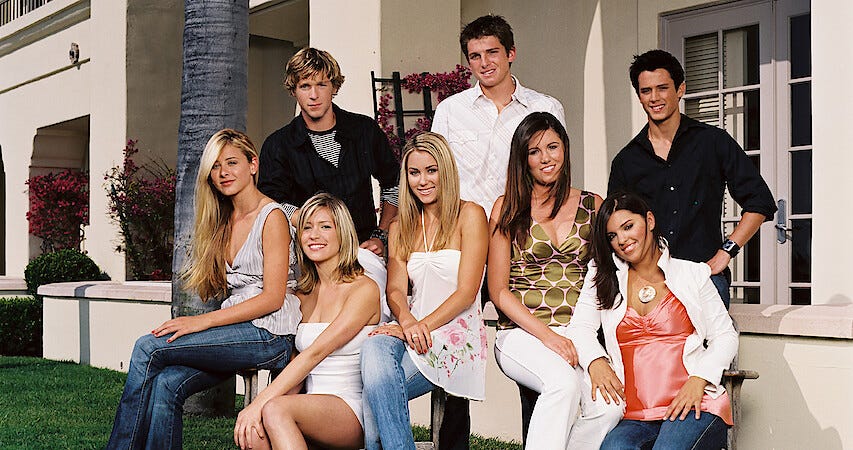Takeaways from 2005
It's midway through the year that's midway through the decade. But let's be gauche about it and go back 20 years
When I was asked to write an ode to 2005, I found myself staring at a blank page for a week.
Everything “noughties” I felt equipped to write about in any depth belonged to the wrong year. Love Actually had been released two years before. Sex and the City: The Movie had infuriatingly missed the mark by three years.
Curious at first, I then started to feel a slight panic. I scavenged for material but nothing stuck.
The problem, it seems, is that it is very hard for an ode to the mid-noughties not to tip into lament. The brutal treatment of celebrities like Paris Hilton and Lindsay Lohan at the hands of the tabloids now makes us shiver. Similarly, the figure of a laddish Russell Brand, synonymous with toxic noughties culture, has since exposed the dark underbelly of these years; the serious allegations the comedian is now facing, and clips of the jokes he used to make on air, have “provided a sobering reminder of the seedier side of the pop and media culture in that decade,” as put softly by the BBC.
At the same time, amid the necessary reckoning, there is much to discuss about the way 2005 changed media and culture forever. For while it didn’t actually give us Love Actually, 2005 was the turning point where media changed forever.
The Simple Life ran from 2003 to 2007, surviving a 2005-era feud between stars Paris Hilton and Nicole Richie
Reality TV, in particular, was going through a quiet revolution in 2005, turning the genre from what it once was into what we recognise it as today: a change best embodied by the show Laguna Beach, which premiered in 2004 but peaked mid-decade (and is now available on Netflix). Off the back of the success of The OC — a show about the shifting loyalties among a group of privileged young adults in Orange County, California — Laguna Beach followed a group of real students from Laguna Beach High School and the trials and tribulations of their daily lives.
This was a watershed moment in the history of the genre: for while it wasn’t the first time Reality TV cast a voyeuristic lens on ordinary people (Big Brother had paved the way for that years before). Yet as explored in Unreal: A Critical History of Reality TV, Laguna Beach was the first show to really style everyday teen life as if it were a scripted drama.
This was deliberate; producers wanted to show the similarities between The OC and the lives of these “real” teenagers. It was the moment Reality TV became cinematic; there were more angles, higher quality cameras and impossibly glamorous lives on show. The line between fiction and reality had been impossibly blurred — a device that would later crop up in drama. Take Succession, in which Jesse Armstrong deliberately shakes the camera or zooms in heavily on one of his characters’ faces, telenovela-style, as if to ask whether this is fiction or documentary. (Yes, yes, we get it: it’s the Murdochs! Very clever.)
The real-life stars of Laguna Beach, which ran from 2004 to 2006
But it is in reality TV itself that the impact of 2005 is most obviously felt. Franchises like Keeping Up With the Kardashians, The Real Housewives, and in the UK, Made in Chelsea, all blur reality and fiction to make it feel like we are watching a drama of those with enviable lifestyles, with the added bonus that we can follow the real people on Instagram.
That same year, The X Factor began to take off in the UK. This was yet another sign that reality TV was evolving to become what we now recognise today in shows like Love Island. It wasn’t just spectacle anymore, but an interactive ecosystem, where fans voted, followed, and were emotionally invested.
Meanwhile, Brokeback Mountain premiered, marking a different kind of turning point: the mainstreaming of queer stories previously left out of the cultural centre. In both cases, 2005 revealed that audiences weren’t passive. They wanted to connect, influence, and be seen.
Then came YouTube.
Launched in 2005 originally as a dating app, YouTube would go on to leave a lasting legacy that arguably tops that of anything else produced twenty years ago. Before it, MySpace had laid the groundwork for online self-curation. Meanwhile, reality TV had shown that ordinary people could make great content.
When YouTube launched, it devoured everything that had come before it and quickly became the new home for self-publishing, personality-driven storytelling and viral culture. Before, you needed a set; a production crew; a contract. Even then, your moment in the sun was likely limited to how long you were on TV.
All that was needed now? A webcam and a chair, and with it the potential to make a lasting legacy and huge sums of cash. In this sense, YouTube not only changed how media was distributed; as Richard Osman recently noted, the platform “democratised” media in a way that reality TV up to this point had not. People with no industry connections could now find an audience through YouTube, grow it, and monetise it.
The “first ever” YouTube video: Me At The Zoo
Stormzy used the platform to build his early career in grime music, uploading his freestyles to help him gain a following in the underground grime scene. Molly Mae, a very different type of content creator, used the platform to build on the fame she had found from reality TV and catapult herself to new levels of stardom. To this day, she remains the most successful Love Islander, in large part because of her ability to use YouTube to promote her brand and products.
YouTube has left an indelible mark on Reality TV itself. Although the genre has always thrived on drama and chaos, the birth of YouTube, whose appeal largely derives from showing people in their natural habitats, changed the way that reality TV was shot. In The Real Housewives of Beverly Hills, for instance, production is now not afraid to include moments where we see the cast run off crying in what is clearly not a planned moment; think Kyle Richards fleeing a fight between Lisa Rinna and her sister, Kim, over dinner in Amsterdam. The entire segment, for that matter.
YouTube has even changed what “success” looks like to a younger generation; on a recent trip to Hong Kong, I was told that children now want to become successful influencers ahead of doctors or lawyers. We see this in the UK, too; according to a recent survey, one in five children want to be a social media influencer when they grow up.
When we look at the year through a media lens, then, it becomes more than just the halfway point of a problematic decade. It is a turning point: the year we began to perform for each other, for strangers, and ultimately for the platforms themselves. It’s Paris Hilton crying en route to jail while her mother blasts Xtina’s ‘Candyman’ in the car for all to hear; and Kim Kardashian taking selfies while driving her sister Khloe to jail, only a few years later.
YouTube, then, is 2005’s ultimate legacy. The platform now boasts around 2.7 billion monthly users across over 100 countries, ranks as the second most visited website globally, following Google, and is now seen as the only true competitor to Netflix. When you think about the vast fluctuation in use of other social media platforms, like Facebook, it is remarkable that a platform launched 20 years ago could still have such power.








